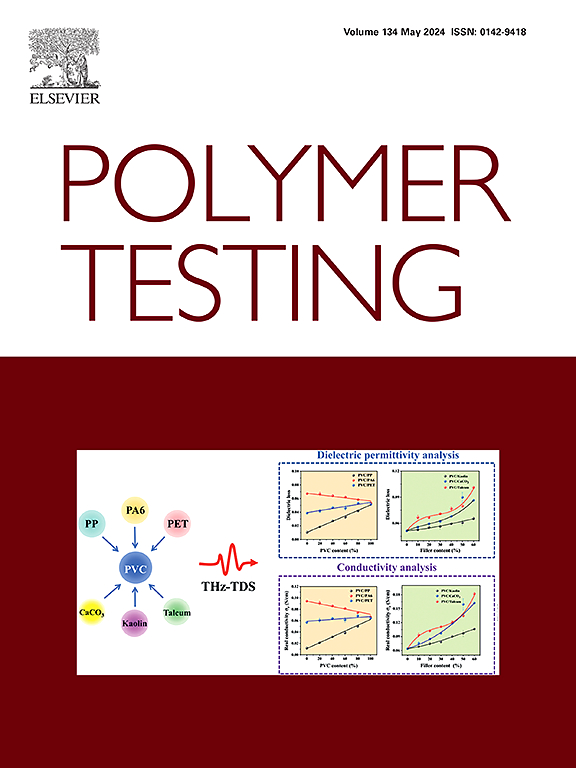Lightweight and high performance nano-cellular poly(lactic acid)/poly(3-hydroxybutyrate-co-4-hydroxybutyrate) foams characterized by high volume expansion ratio
IF 5
2区 材料科学
Q1 MATERIALS SCIENCE, CHARACTERIZATION & TESTING
引用次数: 0
Abstract
An efficient method was developed to fabricate nano-scale poly(lactic acid) (PLA) foams with high volume expansion ratio (VER) aiming at optimizing their properties and cost-effectiveness. The introduction of chain extender ADR (1 wt%) provided enhanced melt strength maintaining cell growth, which created conditions for high value of VER during foaming. The appropriate amount of poly(3-hydroxybutyrate-co-4-hydroxybutyrate) (P34HB) promoted the crystallization performance and melt strength of samples, which not only facilitated local adsorption of CO2 and bubble nucleation but also effectively avoided the excessive growth of cells. The impacts of P34HB and ADR as well as foaming temperature were systematically investigated to obtain the optimum conditions for preparing nano-foams with high VER. It could be concluded that the composite foams possessing optimal cell structures were prepared under 113 °C with 3 wt% P34HB content. The foams exhibited an exceptional combination of cell diameter approaching 150 nm, cell density achieving 2.5 × 1015 cells/cm3, and VER reaching 4.6, exceeding the results reported in existing literatures. The referred foams displayed excellent compression behaviors and superior thermal insulation performances. Generally, the foams fabricated in this work would show broad application prospects in various fields for their outstanding nano-structure and VER.

轻量化、高性能的纳米多孔聚乳酸/聚(3-羟基丁酸-co-4-羟基丁酸)泡沫塑料具有高体积膨胀比的特点
为优化纳米级高体积膨胀比(VER)聚乳酸(PLA)泡沫材料的性能和成本效益,研究了一种制备高体积膨胀比(VER)纳米级聚乳酸(PLA)泡沫材料的方法。扩链剂ADR (1 wt%)的加入提高了熔体强度,维持了细胞的生长,为发泡过程中高VER值创造了条件。适量的聚(3-羟基丁酸-co-4-羟基丁酸)(P34HB)提高了样品的结晶性能和熔体强度,不仅有利于CO2的局部吸附和气泡成核,而且有效地避免了细胞的过度生长。系统考察了P34HB、ADR以及发泡温度对制备高VER纳米泡沫的影响,得到了制备高VER纳米泡沫的最佳条件。综上所述,在温度为113℃、P34HB含量为3 wt%的条件下,制备出具有最佳孔结构的复合泡沫材料。泡沫的胞直径接近150 nm,胞密度达到2.5 × 1015胞/cm3, VER达到4.6,超过了现有文献报道的结果。所述泡沫材料具有优异的压缩性能和保温性能。综上所述,本研究制备的泡沫材料具有优异的纳米结构和VER特性,在各个领域具有广阔的应用前景。
本文章由计算机程序翻译,如有差异,请以英文原文为准。
求助全文
约1分钟内获得全文
求助全文
来源期刊

Polymer Testing
工程技术-材料科学:表征与测试
CiteScore
10.70
自引率
5.90%
发文量
328
审稿时长
44 days
期刊介绍:
Polymer Testing focuses on the testing, analysis and characterization of polymer materials, including both synthetic and natural or biobased polymers. Novel testing methods and the testing of novel polymeric materials in bulk, solution and dispersion is covered. In addition, we welcome the submission of the testing of polymeric materials for a wide range of applications and industrial products as well as nanoscale characterization.
The scope includes but is not limited to the following main topics:
Novel testing methods and Chemical analysis
• mechanical, thermal, electrical, chemical, imaging, spectroscopy, scattering and rheology
Physical properties and behaviour of novel polymer systems
• nanoscale properties, morphology, transport properties
Degradation and recycling of polymeric materials when combined with novel testing or characterization methods
• degradation, biodegradation, ageing and fire retardancy
Modelling and Simulation work will be only considered when it is linked to new or previously published experimental results.
 求助内容:
求助内容: 应助结果提醒方式:
应助结果提醒方式:


